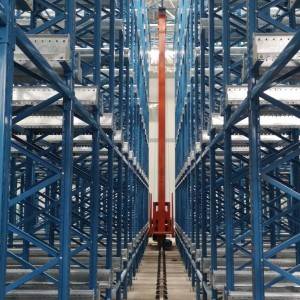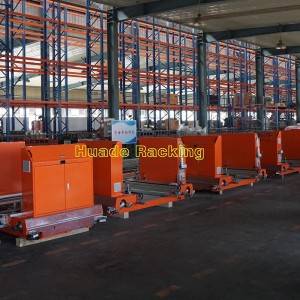Four-Way Shuttle
Short Description:
4-Way shuttle is an automated handling equipment for high-density storage system. Through the 4-way movement of the shuttle and the level transfer of the shuttle by the hoist, the warehouse automation is achieved.
4-Way shuttle is an automated handling equipment for high-density storage system. Through the 4-way movement of the shuttle and the level transfer of the shuttle by the hoist, the warehouse automation is achieved. This smart material handling equipment can travel in 4 directions working efficiently and flexibly across multiple lanes and making full use of space with less restriction. The shuttle connects to the RCS system via wireless network, and travels to any pallet location working with the hoist.
The four-way shuttle is equipped with an independent PLC to control the walking, steering, and lifting.
The positioning system transmits the key coordinate position of the four-way shuttle to the PLC.
Information such as battery power and charging status is also sent to the PLC.
The local operation of the four-way shuttle is realized through a handheld terminal via wireless communication.
When an alarm occurs, the four-way shuttle is switched to manual mode and stopped normally. Emergency stop is used only when the shuttle position exceeds the limit, or there is collision, or emergency stop alarm occurs.

a. The four-way shuttle has the following safety functions:
Rail boundary collision protection
Anti-collision protection for obstacles in the rail track
Anti-collision protection for obstacles in the racks
Overcurrent protection for motor
Protection of battery short circuit / over current / under voltage / over voltage / high temperature
b.The four-way shuttle has the following detecting functions:
Pallet detection when picking up
Empty pallet location detection before storing pallet
Load detection on the shuttle
Robot path planning and robot traffic management allow the robot clusters to work together in coordination, to cooperate with each other without affecting each other and consequently maximize the performance. RCS is also responsible for monitoring the operating status of the robots, recording the status of each robot, and further determining whether the maintenance for specific robot is required. Considering the operating status of the charging station and the current task execution, RCS arranges necessary charging direction for robots in need of power, records, summarizes and analyses all the alarm information coming from the robots, then notifies the maintenance personnel, advises diagnosing and repairing methods, and further ensures the reliability of the entire system.




